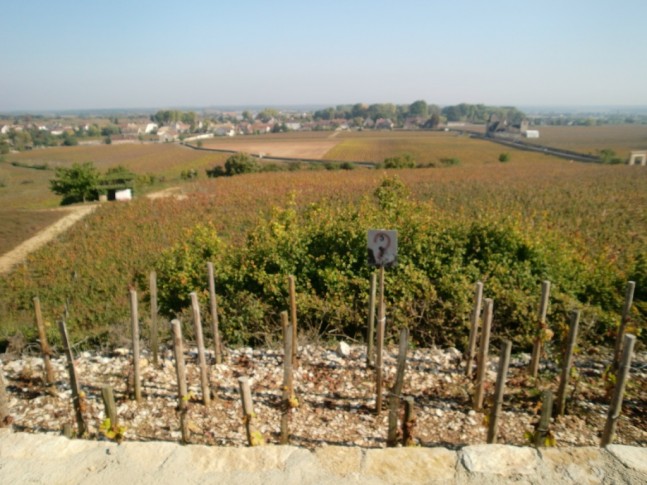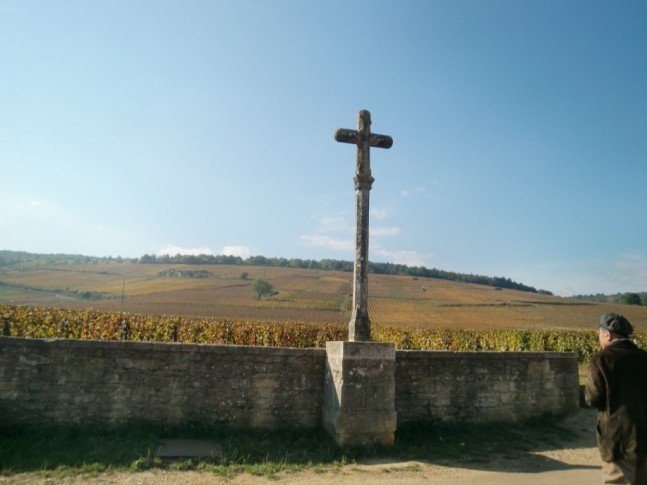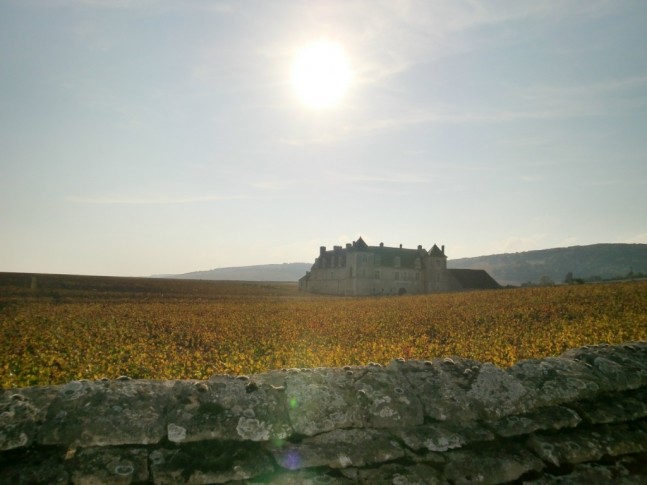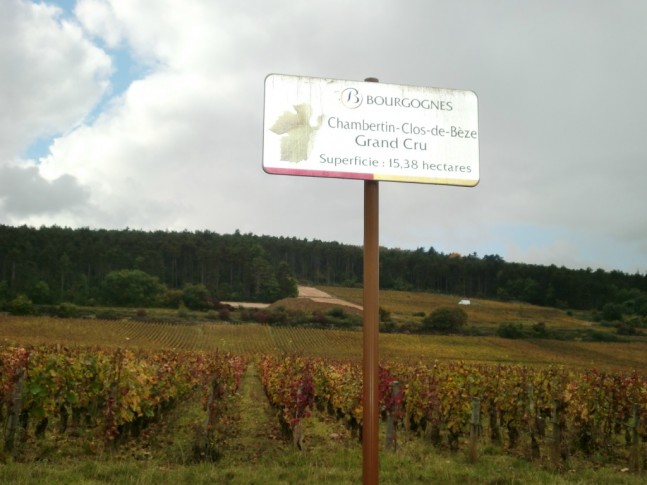03/11/2011 PART 3 of the Burgundy Series
The story behind Pinot Noir, philosophy of the Burgundians and some tasting notes.
“Let me show you something you would find interesting,” said my guide, Elohim Balest.
He drove me to a spot where some stakes were standing by themselves.
“In the past, this was how Pinot Noir was grown. The monks used to tie the vines to the stakes and the vines were planted in a haphazard order.”

Shalom Burgundy Blog - vine stake old method
I understood what he meant as some parts of Spain still grows bush vines in the similar manner. Elohim went on further to explain that the word “pinot” meant conical which referred to the Pinot Noir bunches had the shape of a pine fruit. The word “pinot” also has its origins from an old French word which meant “unique” because there was only one bunch per vine.
Today, the vines are now producing more than just one bunch per vine but that doesn’t mean that there are a lot of Grand Cru wines to go around. Yields are exceptionally low in Grand Cru vineyards which are form 4 to 5 bunches per vine. For some vineyards like Leroy’s, there are only 2 to 3 bunches per vine.
This belief of producing low yields for each vine is that the lesser grapes there are, the more concentration of flavour there is. Some new world proponents would say that lower yields do not mean better quality. The Burgundians would beg to differ. To them, it is not just about low yields, but if the land is able to encourage a vine to have lots of growth, then it will never even be within the 1er Cru designation.
The grapes can be made into drinkable wine but never great wine. The soil structure is always taken into consideration when deciding whether a vineyard is a Grand Cru. For example, Romanée-Conti has 60-70 % limestone and 30 % clay. The small amount of clay is very important to store some water for the vine and for the roots to be able to dig deep. If the soils were totally limestone, it would very difficult for the vine roots to penetrate the soil to find any underground water.

Shalom Burgundy Blog - A man whos knows the wines or DRC is paying homage to The sacred Cross of Romanee Conti
In fact, this is one of the magical elements of Burgundy. In most places, there are natural underground rivers running deep under the land to act as reserves for the vines during very dry years. This is true as most wineries I have gone to have their own wells in their underground cellars and showed me rivers running beneath their property. Even the famous Hospice de Beaune has an underground river for public viewing.
Take the size of the famous vineyard, La Romanée, which is only about one hectare in size. Domaine de le Romanée Conti produces about 4500 bottles per year. Griotte-Chambertin, another grand cru vineyard is only 2.69 hectares (Griotte means morello cherries which is exactly what wine from here smells like.
There is a history behind every name of each vineyard). Clos de Vougeot is the biggest grand cru vineyard in Burgundy with about 50 hectares. Yet, due to Napoleonic laws of succession which states that the land must be split equally among all the rightful offsprings of the vineyard owner, we have many small parcels of the Clos being owned by different vignerons. This explains why each vigneron makes such small quantities of wine every year.

Shalom Burgundy Blog - The castle of Clos de Vougeot
Consider the small amounts of bottles that a Grand Cru vineyard can produce and then divide that by the number of vignerons for that vineyard. You do the maths. There isn’t a lot to go around and therefore, the wines do not come cheap. Unless the vineyard is a monopole (owned by one vigneron), we are looking at small numbers produced by each vigneron every year.
Burgundy is a region that is known for its Pinot Noir more than its Chardonnays. In fact, the whole of the Côte de Nuits produces all of the region’s Grand Cru reds and the Côte de Beaune produces all of the region’s Grand Cru whites. Yet, the statistics say that 31% of the region produces red wines and 60% are white wines. The rest are Crément which is 8% and Rosés which is 1%. This is not surprising considering that Chablis and Mâcon produce mostly red wines.I asked Elohim about Musigny Blanc which was the only Grand Cru white from the Côte de Nuits.

Shalom Burgundy Blog - Chambertin Clos de Beze Grand Cru
“You know, Shalom, not many people know about the Musigny Blanc. The quantities are so small that you don’t even see it sold anywhere. Wines like these are like UFOs. You hear of them but you never see them,” said Elohim.
I like Elohim’s UFO theory. It is true there are many great wines in Burgundy that are not even heard outside of Burgundy.
Burgundy is still a closed region when it comes to welcoming visitors outside of France. This is a region in which unless you have very good connections with the vignerons here, nobody would take the time to show you the depths of Burgundy. It is not difficult at all to visit wine caves and taste wine.
But to uncover the mystery of Burgundy, to dig for the secrets of their methods of vinification and viticulture, there is more than meets the eye. The people here keep mum about everything.
To visit the famous producers here in Burgundy, it should be forewarned that one should expect disappointment and a rude rejection. It is said here in Burgundy that to buy bottles from good producers, one has to be on a special mailing list and there is a long queue. This is always the case for anyone who produces good wines. They do not care about marketing to try and reach you. Instead, you go to them.
And if ever the impossible were to happen and people were to stop going to them, then all the better. To the Burgundians, it only means more great wine for themselves to drink.
Noticeably, the soil of the Côte de Nuits is more orange in colour compared to the Côte de Beaune. Elohim pointed out to be there is more iron in the soils of Côte de Nuits and there is more chalk, less iron and soil that is brown in colour in the Côte de Beaune.
This explains why most of the Grand Cru reds are found in the Côte de Nuits as iron contributes more to the structured tannins and colour that gives longevity to the red wines [I would like to point out that this soil structure is a little like that of Coonawarra which explains why they make very good red wines too. Perhaps if Coonawarra had slopes like Burgundy, they could make great Pinot Noir too but we will never know].
Where else, the brown soil is more energetic and does not produce the same red wines that can be cellared like that of Grand Cru reds. There are less tannins in the wines of the Côte de Beaune which is something you do not need when growing white grapes.

Shalom Burgundy Blog - Caveau Philippe Leclerc
Our first stop was to taste the wines of Philippe Leclerc which produces some every good representations of Gevrey Chambertin. Below are my tasting notes:
2007 Les Bons Bâton 13%abv €9
Med(+) purple in colour. Aromas of earth, lifted sweet cherry notes and hints of flowers. On the palate is a spicy but yet soft texture with moderate acid and tannins, flavours of clove, wood smoke with a medium plus length, slightly smoky finish.
2006 En Champs 13.5% €26
Med purple colour. Beautiful and lifted notes that are like a cake. This is 100% new oak. The tannins are higher than Les Batons, flavours of flower and earth, delicious, a moderate acid level with long length of savouriness.
2008 1er Cru Les Champeaux 13.5% €35
Med purple. Black pepper, spice and a light leather note, some aromas of roses. Tannins like En Champs but a higher acidity. The structure is solid and the flavours of black pepper. A long length with flavours of sweet oak in the back palate.
2009 1er Cru Les Cazetiers 13.5% €39
Med purple. Aromas of Coffee, smoke and cedar, medium intensity. High tannins and chocolate, cedar, wood flavours. I find the wood still dominant as this is a young wine but the length is very long. This vineyard is like a Grand Cru in Gevrey but because of it has too much stone, it is considers a 1er cru.
2002 Chambolle Musigny Les Babilloits 13.5%
Med Garnet. A coffee, mushroom, stony and gamey nose. The palate has a dried flower taste with poise and lots of structure and mouth-feel. A sort of rustic flavour with black tea taste. A masculine wine. Long length.
Next in the series, a look at the vines of Burgundy, more Burgundian philosophy and more tastings.
|
|
Tweet |




One comment to Shalom Chin Burgundy Blog – Part 3 – The story behind Pinot Noir, philosophy of the Burgundians and some tasting notes | Comments Feed
phenomenon or this resolute icpspeetrve does for me: I am 22 years old, have my own growing wine credentials, and have aching, consuming dreams for my life in the world of wine; what does this icpspeetrve do to my passion, my own ideals I chase it shits on any ideas of my future cellar-building, it shits on my esoteric dreams of actually attaining the experience of any of these stuffy, rote’ wines. Yes, of course I absolutely adore wines off the rack that are beautiful that moment, [and maybe my own generation of instantly gratified yuppies is partially to blame] but with this contention we would ignore a ridiculous chunk of wine history, the beauty of past and provenance extend this beyond wines, even. Not everything on earth need be democratized.
The comments are closed.